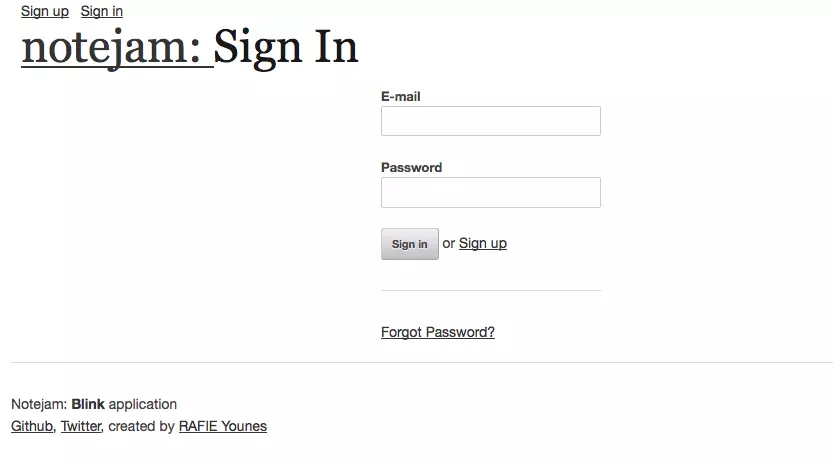Can PHP Be Even Faster? Light-Speed with the Blink Framework
Blink: A High-Performance PHP Framework
You've likely heard of Lumen, Silex, and Slim. Now, meet Blink, a new PHP framework designed for high-performance applications demanding significant server resources. This article explores Blink's capabilities and demonstrates its use through a sample "Notejam" application.

Blink leverages the Swoole PHP extension to achieve its performance goals. Let's dive into the details.
Key Features:
- Performance Optimization: Blink utilizes Swoole for enhanced performance, making it ideal for resource-intensive applications.
- Installation: Installation is via Composer. Note: The current Swoole version requires PHP 5 (not compatible with PHP 7).
- Flexibility: While lacking default templating and database management, Blink seamlessly integrates with popular choices like Twig and Eloquent.
- Notejam Application Example: This article guides you through building a Notejam app showcasing user authentication, session management, and CRUD operations for notes and pads.
- Resource Efficiency: The combined power of Blink and Swoole minimizes server load by keeping application resources active throughout the application's lifecycle.
- Community Driven: As a relatively new framework, Blink welcomes community contributions to documentation and feature development.
Swoole Extension Installation:
Blink's performance relies on the Swoole extension. This guide uses PEAR on Ubuntu 14.04 with a LAMP setup (using Vaprobash; see the project's Vagrantfile for details). (Note: Swoole's current incompatibility with PHP 7 is a factor in this setup choice.)
sudo apt-get update sudo apt-get install php-pear php5-dev libcurl3-openssl-dev sudo pecl install swoole
After installation, remember to add extension=swoole.so to your php.ini file. Verify the extension's loading with:
php -m | grep 'swoole'
(Current Swoole version: 1.7.22-alpha, incompatible with PHP 7; future versions aim to address this.)
Installing Blink:
Use Composer:
composer create-project --prefer-dist blink/seed
Start the server:
php blink server serve
Access the application at http://localhost:7788 (or adjust the port as described below).

Configuration:
While Blink doesn't offer command-line port specification, you can modify the port in src/config/server.php:
<?php return [
'class' => '\blink\server\SwServer',
'bootstrap' => require __DIR__ . '/../bootstrap.php',
'host' => '0.0.0.0',
'port' => 8080,
];Remember to restart the server after making changes. The config directory also houses application and service configurations.
Building the Notejam App:
The Notejam app (available on Github) includes:
- Sign-in (with password reset)
- Sign-up
- Account settings (password change)
- Note and pad management
Integrating Twig (Templating Engine):
Blink doesn't include a default templating engine; we'll use Twig. Modify src/bootstrap.php and add src/bindings.php:
sudo apt-get update sudo apt-get install php-pear php5-dev libcurl3-openssl-dev sudo pecl install swoole
php -m | grep 'swoole'
Integrating Eloquent (Database Management):
For database interaction (users, notes, pads), we'll use Eloquent. Install via Composer:
composer create-project --prefer-dist blink/seed
Then, configure Eloquent in src/bindings.php:
php blink server serve
(Database migrations are handled via src/console/MigrateCommand.php and src/config/app.php.)
Routing, Controllers, and Views:
Routes are defined in src/http/routes.php. Controllers reside in src/http/controllers. Views use Twig templates. The article provides detailed examples of these components for the Notejam app's functionality (sign-up, sign-in, settings, note management). Middleware is used for authentication and authorization.
Sessions and Cookies:
Blink doesn't automatically handle PHP sessions; manual management (using the request object) is necessary.
Conclusion:
Blink, while still in early development, offers a compelling high-performance alternative. The community is encouraged to contribute to its growth and improvement.





The provided FAQs are already comprehensive and well-structured. No further modifications are needed.
The above is the detailed content of Can PHP Be Even Faster? Light-Speed with the Blink Framework. For more information, please follow other related articles on the PHP Chinese website!

Hot AI Tools

Undresser.AI Undress
AI-powered app for creating realistic nude photos

AI Clothes Remover
Online AI tool for removing clothes from photos.

Undress AI Tool
Undress images for free

Clothoff.io
AI clothes remover

Video Face Swap
Swap faces in any video effortlessly with our completely free AI face swap tool!

Hot Article

Hot Tools

Notepad++7.3.1
Easy-to-use and free code editor

SublimeText3 Chinese version
Chinese version, very easy to use

Zend Studio 13.0.1
Powerful PHP integrated development environment

Dreamweaver CS6
Visual web development tools

SublimeText3 Mac version
God-level code editing software (SublimeText3)

Hot Topics
 1393
1393
 52
52
 1207
1207
 24
24
 Alipay PHP SDK transfer error: How to solve the problem of 'Cannot declare class SignData'?
Apr 01, 2025 am 07:21 AM
Alipay PHP SDK transfer error: How to solve the problem of 'Cannot declare class SignData'?
Apr 01, 2025 am 07:21 AM
Alipay PHP...
 How does session hijacking work and how can you mitigate it in PHP?
Apr 06, 2025 am 12:02 AM
How does session hijacking work and how can you mitigate it in PHP?
Apr 06, 2025 am 12:02 AM
Session hijacking can be achieved through the following steps: 1. Obtain the session ID, 2. Use the session ID, 3. Keep the session active. The methods to prevent session hijacking in PHP include: 1. Use the session_regenerate_id() function to regenerate the session ID, 2. Store session data through the database, 3. Ensure that all session data is transmitted through HTTPS.
 Explain JSON Web Tokens (JWT) and their use case in PHP APIs.
Apr 05, 2025 am 12:04 AM
Explain JSON Web Tokens (JWT) and their use case in PHP APIs.
Apr 05, 2025 am 12:04 AM
JWT is an open standard based on JSON, used to securely transmit information between parties, mainly for identity authentication and information exchange. 1. JWT consists of three parts: Header, Payload and Signature. 2. The working principle of JWT includes three steps: generating JWT, verifying JWT and parsing Payload. 3. When using JWT for authentication in PHP, JWT can be generated and verified, and user role and permission information can be included in advanced usage. 4. Common errors include signature verification failure, token expiration, and payload oversized. Debugging skills include using debugging tools and logging. 5. Performance optimization and best practices include using appropriate signature algorithms, setting validity periods reasonably,
 Describe the SOLID principles and how they apply to PHP development.
Apr 03, 2025 am 12:04 AM
Describe the SOLID principles and how they apply to PHP development.
Apr 03, 2025 am 12:04 AM
The application of SOLID principle in PHP development includes: 1. Single responsibility principle (SRP): Each class is responsible for only one function. 2. Open and close principle (OCP): Changes are achieved through extension rather than modification. 3. Lisch's Substitution Principle (LSP): Subclasses can replace base classes without affecting program accuracy. 4. Interface isolation principle (ISP): Use fine-grained interfaces to avoid dependencies and unused methods. 5. Dependency inversion principle (DIP): High and low-level modules rely on abstraction and are implemented through dependency injection.
 How to automatically set permissions of unixsocket after system restart?
Mar 31, 2025 pm 11:54 PM
How to automatically set permissions of unixsocket after system restart?
Mar 31, 2025 pm 11:54 PM
How to automatically set the permissions of unixsocket after the system restarts. Every time the system restarts, we need to execute the following command to modify the permissions of unixsocket: sudo...
 How to debug CLI mode in PHPStorm?
Apr 01, 2025 pm 02:57 PM
How to debug CLI mode in PHPStorm?
Apr 01, 2025 pm 02:57 PM
How to debug CLI mode in PHPStorm? When developing with PHPStorm, sometimes we need to debug PHP in command line interface (CLI) mode...
 Explain late static binding in PHP (static::).
Apr 03, 2025 am 12:04 AM
Explain late static binding in PHP (static::).
Apr 03, 2025 am 12:04 AM
Static binding (static::) implements late static binding (LSB) in PHP, allowing calling classes to be referenced in static contexts rather than defining classes. 1) The parsing process is performed at runtime, 2) Look up the call class in the inheritance relationship, 3) It may bring performance overhead.
 How to send a POST request containing JSON data using PHP's cURL library?
Apr 01, 2025 pm 03:12 PM
How to send a POST request containing JSON data using PHP's cURL library?
Apr 01, 2025 pm 03:12 PM
Sending JSON data using PHP's cURL library In PHP development, it is often necessary to interact with external APIs. One of the common ways is to use cURL library to send POST�...




